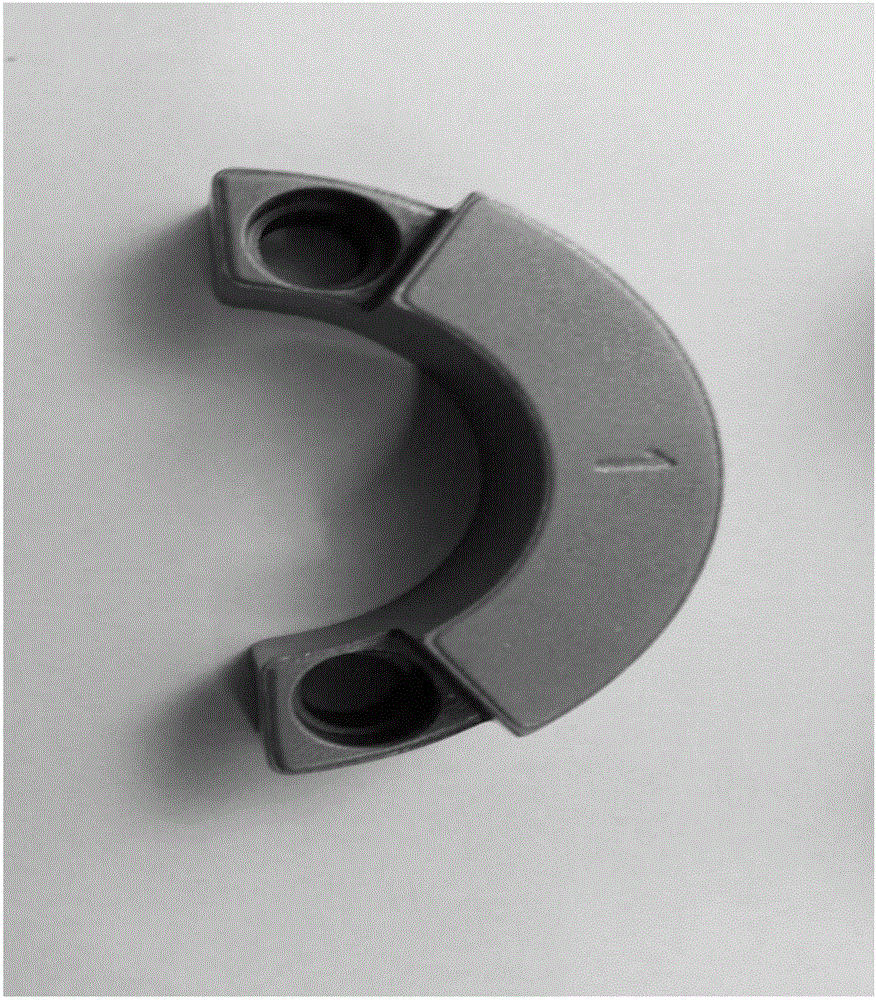Powder metallurgy sintering method of non-magnetic steel structural component
A technology of powder metallurgy and sintering method, which is applied in the field of powder metallurgy, can solve the problems of large size change, large product size tolerance, and large change fluctuation, and achieve the effects of reducing size change, controllable production process, and improving product quality
- Summary
- Abstract
- Description
- Claims
- Application Information
AI Technical Summary
Problems solved by technology
Method used
Image
Examples
Embodiment 1
[0026] A powder metallurgy sintering method of a non-magnetic steel balance weight in this embodiment comprises the following steps:
[0027] (1) According to the conventional method of powder metallurgy, the green body of non-magnetic steel balance weight is made; the green body has through holes, and the green body density is 5.8g / cm 3 ;
[0028] (2) Take out the tray of the powder metallurgy high-temperature sintering furnace, and lay a layer of corundum sand on the bottom of the tray to form a sand cushion layer; the particle size of the corundum sand is 80 mesh, and the thickness of the sand cushion layer is 1mm;
[0029] (3) placing the green body on the cushion sand layer, and then continue to fill the above-mentioned corundum sand in the through hole;
[0030] (4) Push the tray into a powder metallurgy high-temperature sintering furnace, and sinter at a temperature of 1180°C for 1.5h;
[0031] (5) After the sintering is completed, take it out, and carry out the follo...
Embodiment 2
[0033] A powder metallurgy sintering method of a non-magnetic steel balance weight in this embodiment comprises the following steps:
[0034] (1) According to the conventional method of powder metallurgy, the green body of non-magnetic steel balance weight is made; the green body has through holes, and the green body density is 6.2g / cm 3 ;
[0035] (2) Take out the tray of the powder metallurgy high-temperature sintering furnace, and lay a layer of corundum sand on the bottom of the tray to form a sand cushion; the particle size of the corundum sand is 120 mesh, and the thickness of the sand cushion is 1.5mm;
[0036] (3) placing the green body on the cushion sand layer, and then continue to fill the above-mentioned corundum sand in the through hole;
[0037] (4) Push the tray into a powder metallurgy high-temperature sintering furnace, and sinter at a temperature of 1175°C for 1.8 hours;
[0038] (5) Take it out after sintering is completed, and carry out follow-up polishin...
Embodiment 3
[0040] A powder metallurgy sintering method of a non-magnetic steel balance weight in this embodiment comprises the following steps:
[0041] (1) According to the conventional method of powder metallurgy, the green body of non-magnetic steel balance weight is made; the green body has through holes, and the green body density is 6.4g / cm 3 ;
[0042] (2) Take out the tray of the powder metallurgy high-temperature sintering furnace, and lay a layer of corundum sand on the bottom of the tray to form a sand cushion; the particle size of the corundum sand is 150 mesh, and the thickness of the sand cushion is 2mm;
[0043] (3) placing the green body on the cushion sand layer, and then continue to fill the above-mentioned corundum sand in the through hole;
[0044] (4) Push the tray into a powder metallurgy high-temperature sintering furnace, and sinter at a temperature of 1175°C for 2 hours;
[0045] (5) Take it out after the sintering is completed, and carry out follow-up polishin...
PUM
| Property | Measurement | Unit |
|---|---|---|
| particle size | aaaaa | aaaaa |
| thickness | aaaaa | aaaaa |
| density | aaaaa | aaaaa |
Abstract
Description
Claims
Application Information
 Login to View More
Login to View More - R&D
- Intellectual Property
- Life Sciences
- Materials
- Tech Scout
- Unparalleled Data Quality
- Higher Quality Content
- 60% Fewer Hallucinations
Browse by: Latest US Patents, China's latest patents, Technical Efficacy Thesaurus, Application Domain, Technology Topic, Popular Technical Reports.
© 2025 PatSnap. All rights reserved.Legal|Privacy policy|Modern Slavery Act Transparency Statement|Sitemap|About US| Contact US: help@patsnap.com

